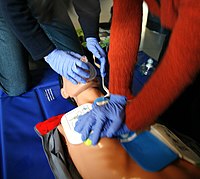
Photo from wikipedia
Importance There are few data on the prevalence or outcome of bystander cardiopulmonary resuscitation (BCPR) in children 18 years and younger. Objective To characterize BCPR in pediatric out-of-hospital cardiac arrests… Click to show full abstract
Importance There are few data on the prevalence or outcome of bystander cardiopulmonary resuscitation (BCPR) in children 18 years and younger. Objective To characterize BCPR in pediatric out-of-hospital cardiac arrests (OHCAs). Design, Setting, and Participants This analysis of the Cardiac Arrest Registry to Enhance Survival database investigated nontraumatic OHCAs in children 18 years and younger from January 2013 through December 2015. Exposures Bystander CPR, which included conventional CPR and compression-only CPR. Main Outcomes and Measures Overall survival and neurologically favorable survival, defined as a Cerebral Performance Category score of 1 or 2, at the time of hospital discharge. Results Of the 3900 children younger than 18 years with OHCA, 2317 (59.4%) were infants, 2346 (60.2%) were female, and 3595 (92.2%) had nonshockable rhythms. Bystander CPR was performed on 1814 children (46.5%) and was more common for white children (687 of 1221 [56.3%]) compared with African American children (447 of 1134 [39.4%]) and Hispanic children (197 of 455 [43.3%]) (P < .001). Overall survival and neurologically favorable survival were 11.3% (440 of 3900) and 9.1% (354 of 3900), respectively. On multivariable analysis, BCPR was independently associated with improved overall survival (adjusted proportion, 13.2%; 95% CI, 11.81-14.58; adjusted odds ratio, 1.57; 95% CI, 1.25-1.96) and neurologically favorable survival (adjusted proportion, 10.3%; 95% CI, 9.10-11.54; adjusted odds ratio, 1.50; 95% CI, 1.21-1.98) compared with no BCPR (overall survival: adjusted proportion, 9.5%; 95% CI, 8.28-10.69; neurologically favorable survival: adjusted proportion, 7.59%; 95% CI, 6.50-8.68). For those with data on type of BCPR, 697 of 1411 (49.4%) received conventional CPR and 714 of 1411 (50.6%) received compression-only CPR. On multivariable analysis, only conventional CPR (adjusted proportion, 12.89%; 95% CI, 10.69-15.09; adjusted odds ratio, 2.06; 95% CI, 1.51-2.79) was associated with improved neurologically favorable survival compared with no BCPR (adjusted proportion, 9.59%; 95% CI, 6.45-8.61). There was a significant interaction of BCPR with age. Among infants, conventional BCPR was associated with improved overall survival and neurologically favorable survival while compression-only CPR had similar outcomes to no BCPR. Conclusions and Relevance Bystander CPR is associated with improved outcomes in pediatric OHCAs. Improving the provision of BCPR in minority communities and increasing the use of conventional BCPR may improve outcomes for children with OHCA.
Journal Title: JAMA Pediatrics
Year Published: 2017
Link to full text (if available)
Share on Social Media: Sign Up to like & get
recommendations!